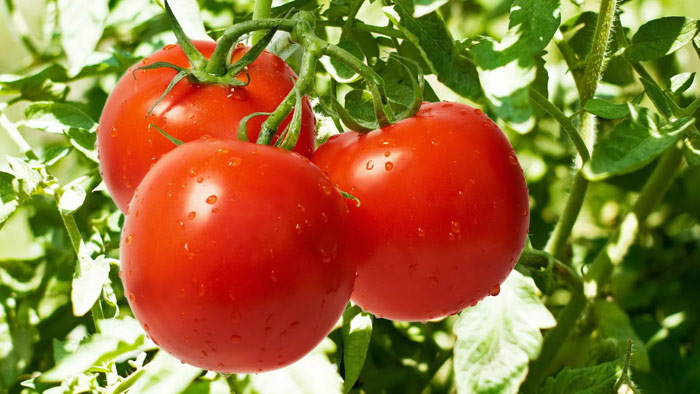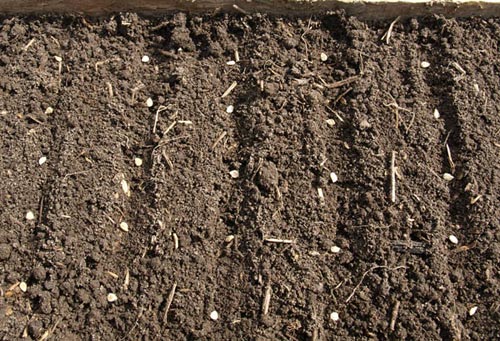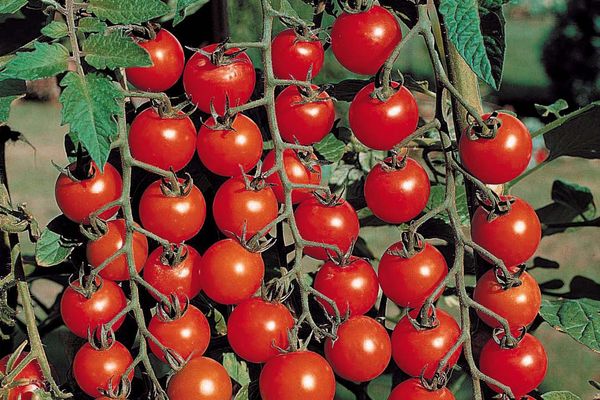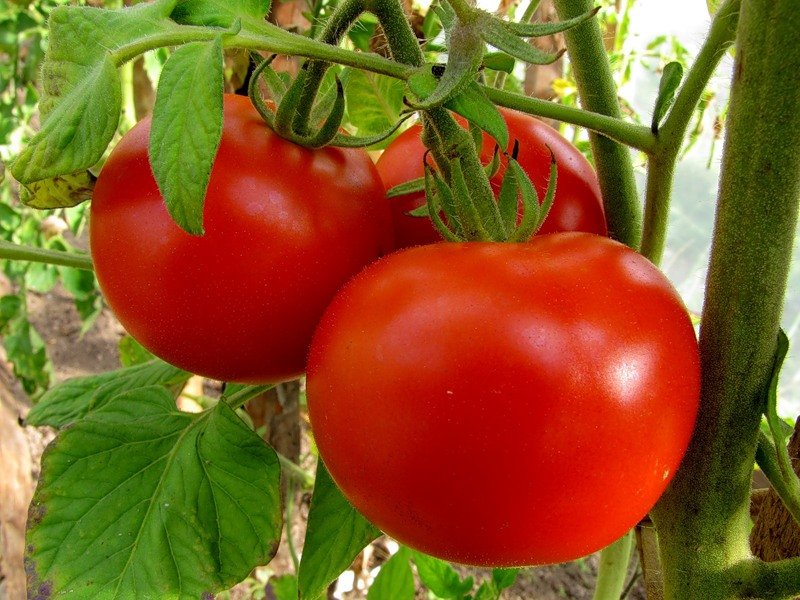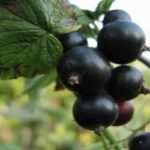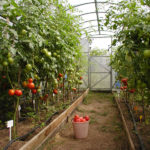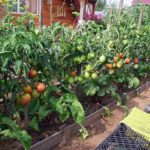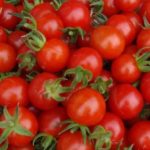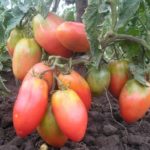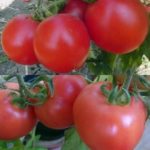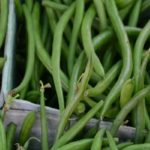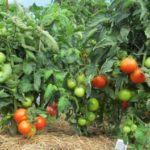A mystery - a super early tomato, selected at the Research Institute of Agriculture of Transnistria. They were brought out recently. Tomatoes are placed in salads, sauces, canned food, pickled, and eaten fresh. This is practically the earliest variety when compared with other types of tomatoes.
What do the bushes look like?
Characteristics of bushes:
- determinant, that is, when flowers are laid at the top, they stop growing;
- short;
- They have a powerful spreading trunk, 45–50 cm in height; in a greenhouse the trunk can be 60 cm.
The description of the tomato The mystery of the stems is simple - medium-leafed.From sowing the seeds to harvesting the tomatoes, 83–87 days pass. An inflorescence grows above the 6th – 7th leaf. Each brush has 5 – 6 tomatoes. The fruit does not have a green spot near the stalk.
Appearance of fruits
Description of the variety:
- fruits are round, slightly ribbed near the stalk;
- tomatoes Mystery scarlet shade;
- thick skin;
- the pulp is sweet, fleshy;
- When over-watered, tomatoes do not crack.
Reviews about the taste are very enthusiastic: the tomatoes were given a tasting score of 5 points out of 5 possible. The weight of the fruit is 75–95 g if it grew on the plot, and 100–110 g if it grew in a greenhouse. 6 - 8 seedlings are planted per 1 m², the yield per 1 m² is 20 - 22 kg of vegetables.
Advantages
Tomatoes have many benefits:
- ultra early ripening vegetables;
- do not crack, transportable;
- good taste, very smooth;
- are not damaged during transportation;
- compact bushes;
- the variety is immune to diseases;
- stepchildren practically do not grow;
- do not slow down growth due to lack of lighting;
- The bushes are easy to care for.
Sowing seeds
Stores sell bags containing 25 seeds of the variety. Buy a bag or collect seeds. Sow the seeds from March 20 and early April, deepening them into the soil by 2 - 3 cm. Remember to water to keep the soil moist, but do not overwater the seedlings.
When 1–3 true leaves grow, drop the seedlings into separate plastic cups and feed them with mineral fertilizer. If you transplant seedlings into one large container, then make a distance between seedlings of 8 cm.
Planting seedlings in the ground
To plant seedlings, select an area well lit by sunlight and protected from cold winds.
In autumn, spread 2–3 kg of manure per 1 m² and dig up the soil to the depth of a shovel.In the spring, pour 40 g of potassium sulfate, 50 g of superphosphate, 30 g of ammonium nitrate onto 1 m² of land and dig up the soil.
Anyone who has grown tomatoes knows that seedlings are planted in the ground in May, 55 - 60 days after sowing the seeds. This is done as soon as the risk that the seedlings will fall under return frosts has disappeared. Plant in the evening or during the day when there is no sun. Dig holes, making a distance of 40 cm between them, and 50 cm between the rows, or keep a distance of 30 cm between the holes, and 60 cm between the rows. Place the seedlings with a lump of earth in the hole and cover them with soil up to the first leaf. Compact the soil, then water the soil twice.
Care
Water the bushes generously in the evening with warm water, but do not allow drops of water to fall on the leaves. Very few stepchildren grow. Be sure to tear off the stepsons: if you place them in the ground, they will take root very quickly and new bushes will grow from them. There is no need to tie up the bushes.
Pull out weeds and loosen the soil after each watering to prevent a crust from forming. Mulch the ground with last year's straw or sawdust that has been lying around for about a year. You should not use fresh sawdust - they make the soil acidic.
A week after planting the seedlings, feed the bushes with mineral fertilizers. Then feed the first bunch of tomatoes when they ripen.
Many people who grew bushes were convinced that Riddle is a super early variety, although it is not resistant to late blight, but due to the fact that the tomatoes ripen before the massive spread of late blight and other diseases, they are not attacked by pests and do not require treatment with fungicides. You can harvest tomatoes from the second week of June. From 1 hectare you can harvest 30 - 40 tons of tomatoes.
How to collect seeds
Leave the first tomato that turns red to seed and let the fruit grow until it is fully ripe. Then pick it, squeeze the seeds into a glass containing 1/3 water, leave for 2 - 3 days, then the seeds will sink to the bottom. Drain the water, rinse the seeds and dry.
In addition to the “Riddle” variety, there are other early varieties.
Early varieties of tomatoes
The tomato Mystery of Nature is completely different from the Mystery variety. He is indeterminate. The fruits are yellowish in color and the skin at the base is pink. The pulp is also yellowish with pinkish places, very sweet, tender, grainy. This variety is planted in greenhouses. Anyone who planted it knows that the bushes are very powerful and tall: 1.5 - 1.9 meters in height, fruit weight 350 g. When forming the stem, break off the top, constantly tear off the stepsons. Form bushes into 1 - 2 stems. You can collect 7 kg from a bush. These tomatoes can be consumed even by allergy sufferers who are allergic to red tomatoes.
Tomato Zinaida F1 - this hybrid is planted in open ground and in a greenhouse. It takes 85–90 days from the appearance of the first shoots to harvest, that is, the variety is early ripening and determinate. The height of the bushes is 70 – 89 cm.
Features of the fruit:
- rounded;
- no lime-colored spot in the stalk area;
- have a scarlet color;
- weight 130 – 140 g;
- good taste.
This is a high yielding variety. They harvest 13 - 15 kg per 1 m² of plantings, it can be easily transported over long distances, the variety is resistant to tomato diseases.
The Vyuga tomato is a hybrid; the tomatoes ripen early and are planted in a summer cottage. The tomatoes are oval, similar in shape to pears, smooth, scarlet, their weight is 90 - 100 g. Vegetables have a great advantage over other varieties, they are perfectly preserved: up to 90% within a month. But in 12 days, milk-ripe tomatoes ripen completely.
Tomatoes that have the word “mystery” in their name include a variety called the Rose Valley Mystery. This is a mid-season variety; it is planted both in garden plots and in greenhouses. The bushes are indeterminate and tall, so they need to be tied up and pinched. The tomatoes are shaped like a very large plum, bright pink, and have a dessert taste.
So if you want to plant a tomato whose fruits ripen most quickly, then choose tomatoes of the Riddle variety. Due to the rapid ripening of tomatoes, the bushes do not have time to get sick and are not affected by pests.

